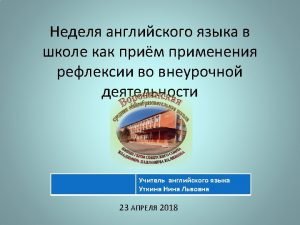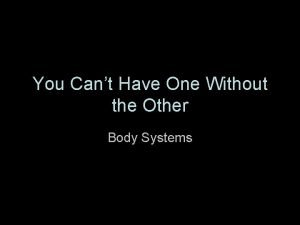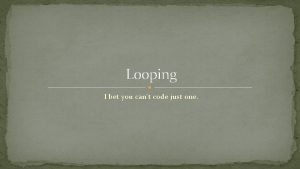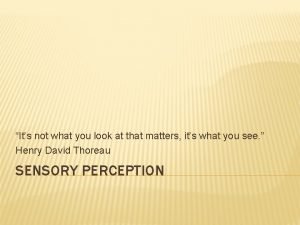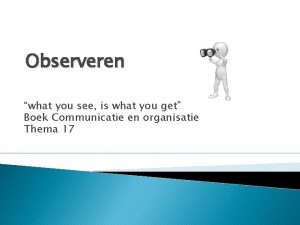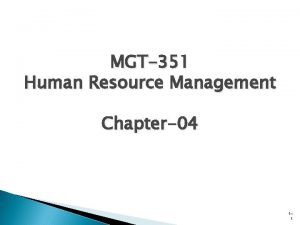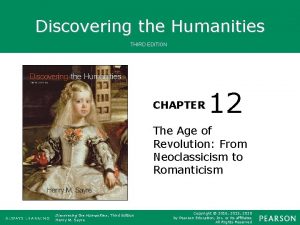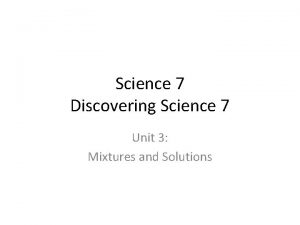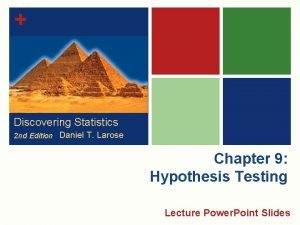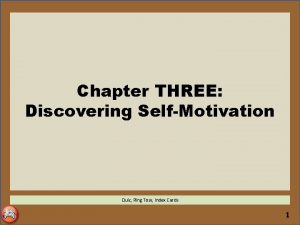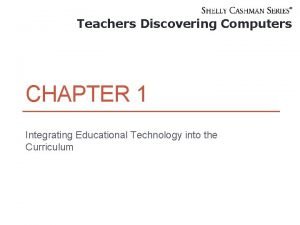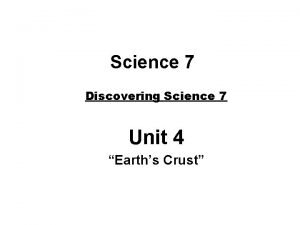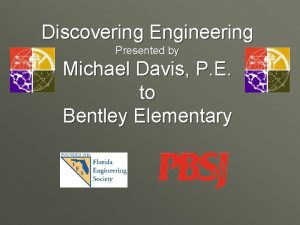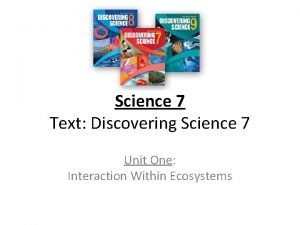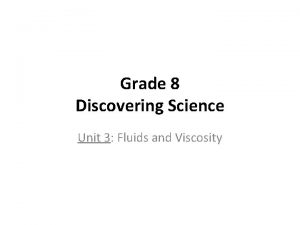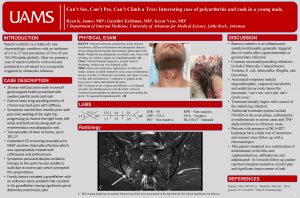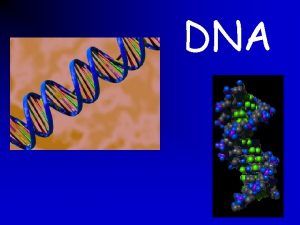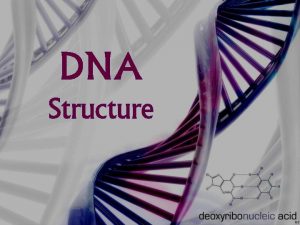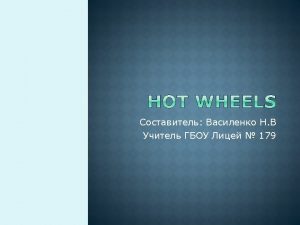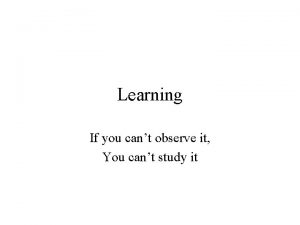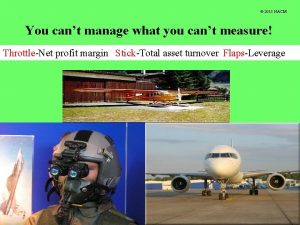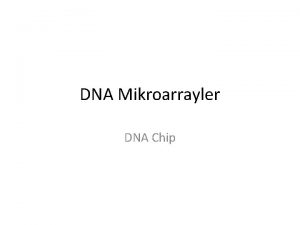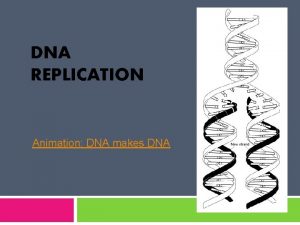DISCOVERING DNA If you cant see it how






































- Slides: 38

DISCOVERING DNA If you can’t see it how can you tell what it is made of? (Also: Replication & RNA)

DNA GROUND ZERO: WHAT WE KNEW TO START WITH • 1) Parents pass genetic traits on to their offspring • (inheritance) • 2) Chromosomes in a cell’s nucleus carry the traits • 3) Chromosomes are made of DNA and Proteins •

CONTRIBUTED TO DISCOVERING THE STRUCTURE OF DNA • 1) Griffith – bacteria give genetic traits to other bacteria. • the trait they passed on was ability to secrete a capsule • • Didn’t know if DNA or protein was being traded

• 2) Avery – 1 st to show DNA is the genetic material. • Showed that only DNA could transfer a trait from one bacteria to another…. • give rough bacteria the ability to make a capsule

3) HERSHEY AND CHASE – CONCLUSIVE EVIDENCE THAT DNA IS GENETIC MATERIAL • Background: • 1) Viruses are only made of DNA and Protein • 2) Viruses transfer their genes to other cells • 3) DNA has phosphate, but Protein does not • 4) Bacteriophage Viruses inject genetic material into bacteria

• Hershey and Chase Experiment: • 1) create viruses with radioactive DNA • 2) Let viruses put their genetic material into a bacteria • 3) If the bacteria is then radioactive, the genetic material • is DNA • 4) If the bacteria is NOT radioactive, the genetic material • is Protein


4) CHARGAFF • Showed that there was always the same amount of A nucleotides as T nucleotides • and • There were always the same amount of G as C • Chargaff’s Rule: A=T G=C • Clue this gave Watson and Crick…. .

5) FRANKLIN • Background: • DNA molecules are too small to see with a microscope • Visible light’s wavelenth is too long & goes around it • X – rays have shorter wavelenth and bend around DNA • Bending light is called diffraction • The pattern of bending can be used to identify the shape of the object that bends it

• Franklin’s Experiment – • Took X-ray diffraction photos of DNA • Measured the diffraction patterns and concluded • DNA was a helix and calculated the diameter of the DNA molecule

6) WATSON & CRICK • Based on the fact that DNA contains the 5 -carbon sugar Deoxyribose. • Based on Chargaff’s Rule : DNA contains the nitrogenous bases A, T, G and C • Based on Franklin’s photo showing a helical shape

CONSTRUCTED THE FIRST WORKING MODEL OF DNA’S STRUCTURE

THE PLAYERS: • 1) Griffith – bacteria give genetic traits to other bacteria. • 2) Avery – 1 st to show that DNA is the genetic material. • 3) Hershey & Chase – Showed conclusively that DNA is the genetic material • 4) Chargaff – A = T and G = C • 5) Franklin – x-ray diffraction

DNA STRUCTURE • DNA is made of subunits called Nucleotides • Nucleotides are made of 3 parts • 1) one 5 carbon sugar • 2) phosphate • 3) nitrogen containing base

• Nucleotides are bonded together in 2 chains • covalent bonds hold one nucleotide to the next • The strong bonds between phosphates and sugars forms the backbone of the double helix

• 2 chains of nucleotides are held together by weak • Hydrogen bonds between their bases

• The two joined chains are twisted into a double helix. • The cell stores DNA wrapped around proteins called histones to form a bundle called a nucleosome • Further wrapping of DNA forms the X-shape • Seen in mitosis • http: //www. youtube. com/watch? v=yq. ESR 7 E 4 b_8


SEMI CONSERVATIVE REPLICATION • http: //www. wiley. com/college/boyer/0470003790/animations/replication. swf • One double helix is replicated so there are 2 double helixes. • 1 molecule of DNA becomes 2 molecules of DNA • Each molecule retains one of the original chains of nucleotides

REPLICATION ORIGINS AND REPLICATION FORKS • In eukaryotes replication takes place at multiple replication origins at the same time. • The area where the 2 strands of parental DNA are being separated is a • Replication fork

PARENT VS DAUGHTER STRANDS • The original DNA strands (chains of nucleotides) are called Parent strands. • The strands formed of new nucleotides are called daughter strands • Daughter strands are complimentary to parent strands • The two strands are antiparallel (5’ -> 3’ and 3’ -> 5’)

DNA REPLICATION ENZYMES TO KNOW • Helicase • Topoisomerase • Primase • DNA polymerase • DNA ligase

DNA REPLICATION ANIMATIONS • http: //sites. fas. harvard. edu/~biot ext/animations/replication 1. swf • http: //www. wiley. com/college/pr att/0471393878/instructor/anim ations/dna_replication/index. ht ml

DNA REPLICATION • Location = nucleus • 1) Helicase unwinds double helix & breaks Hbonds • 2) SSBP proteins keep parental strands apart • 3) Topoisomerase cuts DNA to let it untwist then puts it back together • 4) Primase matches RNA primer to parent strand • 5) DNA Polymerase adds DNA nucleotides to 3’ end of RNA primer to grow the daughter strand from 5’ -> 3’

DNA PROOF READING & REPAIR • DNA Polymerases proofread as they build • After replication…. • damage caused by chemicals & radiation • DNA constantly monitored & repaired • Nuclease enzymes cut out errors • DNA Polymerase fills in correct code where the error was cut out

THYMINE DIMER • Caused by u-v light on skin cells • Thymine bases on same strand form covalent bond to each other instead of to their Adenine partners on the complimentary strand. • Nuclease- cuts out dimer • Polymerase synthesizes new strand by base pairing • Ligase fuses new DNA in

MUTATIONS • If DNA is replicated with an error still in place… • The error is permanent and = a mutation • Mutations in germ cells or gametes can be passed on to offspring • Most mutations are neutral or bad, a few are good • Mutation is the source of variation that allows natural selection

AGING CHROMOSOMES • Every time a chromosome is replicated it gets shorter • To keep from losing genes eukaryotes have telomeres • … long stretches of non-coding DNA at the end of each chromosome • Telomere length is restored in germ cells by telomerase • Gene for telomerase is not active in somatic

THE OTHER NUCLEIC ACID • DNA • RNA • Deoxyribonucleic acid • Ribonucleic acid • Both use phosphate • Bases are GCAU • Bases are GCAT • Single stranded molecule • Double stranded molecule • Both use phosphate

NITROGENOUS BASES IN NUCLEOTIDES • Pyrimidines include : • Cytosine, Thymine, Uracil • Pyrimidines have only one carbon ring • Purine include; • Guanine, and Adenosine • Purines have 2 carbon rings

NUCLEOTIDES AND EVOLUTION • Nicotinamide adenine dinucleotide (NAD) – RNA dinucleotide used as a co-enzyme by all 3 domains of living cells. • Nucleotide structure and base pairing conserved in all organisms and viruses • Evidence of evolution from a universal common ancestor • Semiconservative replication in all organisms & viruses • Prokaryotes : circular double helix DNA • Eukaryotes : multiple liner double helix DNA molecules (combined with histones form chromosomes)

VOCAB. • Chromosome – • naturally occurring segment of DNA and associated proteins • Linear in Eukaryotes • Circular in Prokaryotes

CHROMOSOME FORMS • I. Chromatin • A. DNA wrapped around histones • B. no supercoiling • C. Most DNA available for transcription • D. not visible under microscope • II. Chromatid • A. nucleosomes supercoiled into compact ‘arms’ • B. DNA packaged for transport not use

CONDENSED CHROMATIDS • Constriction in center = • centromere • = a region of DNA that binds to cohesin proteins that function to hold sister chromatids together • Other cohesins hold sister chromatids together more loosely along their lengths

SISTER CHROMATIDS • Identical: each chromatid = one of the double helix molecules made by replication • Formed by semi-conservative replication • While joined at centromere = 1 chromosome

DIFFERENTIAL GENE EXPRESSION • Means different cells express different genes • Even though all cells in a body have the exact same DNA • The gene that codes for making telomerase is in every cell, but is only activated/used in germ cells that make eggs and sperm

GENE EXPRESSION CAN BE CONTROLLED BY: 1) Bonding functional groups to histones a) Histone acetylation encourages use of gene b) Histone methylation inactivates gene

2) Bonding functional groups to the DNA a) DNA methylation inactivates genes b) When methylated genes are replicated the daughter strand will be methylated too…passing on the inactive gene state.
 You cant manage what you dont measure
You cant manage what you dont measure If you can't measure it you cannot improve it
If you can't measure it you cannot improve it Why cant we see atoms
Why cant we see atoms Why we cant see air
Why we cant see air If you can't measure it, you can't manage it
If you can't measure it, you can't manage it You cant manage what you dont measure
You cant manage what you dont measure If you cant beat them join them
If you cant beat them join them You cant have one without the other
You cant have one without the other I bet you cant
I bet you cant Close your eyes to what you cant imagine
Close your eyes to what you cant imagine It's not what you look at that matters, it's what you see.
It's not what you look at that matters, it's what you see. If you could see the future what would you do
If you could see the future what would you do Glad to see you anton
Glad to see you anton Good afternoon buenas tardes
Good afternoon buenas tardes Observatiedoelen
Observatiedoelen Replication fork
Replication fork Bioflix activity dna replication lagging strand synthesis
Bioflix activity dna replication lagging strand synthesis Coding dna and non coding dna
Coding dna and non coding dna Enzyme involved in dna replication
Enzyme involved in dna replication Chapter 11 dna and genes
Chapter 11 dna and genes Participant diary/logs
Participant diary/logs Monk by the sea analysis
Monk by the sea analysis Discovering computers 2018 ppt download
Discovering computers 2018 ppt download Discovering computers 2016
Discovering computers 2016 Discovering computer
Discovering computer Self motivation explain
Self motivation explain Pure substances
Pure substances P value
P value Discovering economic systems comparative worksheet answers
Discovering economic systems comparative worksheet answers Discovering computers 2011
Discovering computers 2011 Chapter 3 discovering self motivation quiz
Chapter 3 discovering self motivation quiz Discovering computers 2018 chapter 1
Discovering computers 2018 chapter 1 Discovering science 7
Discovering science 7 Muhammed computer technology
Muhammed computer technology Discovering engineering
Discovering engineering Defining and debating america's founding ideals
Defining and debating america's founding ideals Teachers discovering computers
Teachers discovering computers Pioneer species
Pioneer species Example of fluid
Example of fluid






